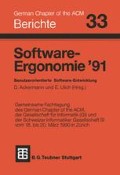Zusammenfassung
In diesem Beitrag wird eine Architektur für direkt manipulative, verteilte Bürosysteme vorgeschlagen. Die klassische Trennung von Ebenen der Präsentation, Dialogsteuerung und Anwendung wird im Prinzip beibehalten. Es wird aber auf Flexibilität und die Möglichkeit der semantischen Rückkopplung in der Präsentationskomponente geachtet. Außerdem wird die Möglichkeit paralleler Dialoge verschiedener Benutzer mit einer Anwendung vorgesehen. Als Werkzeugunterstützung dient ein objektorientierter Oberflächenbaukasten auf der Ebene der Präsentation. Auf der Ebene der Dialogsteuerung ist ein Anwendungsrahmen oder ein flexibles User Interface Management System (UIMS) erforderlich. Als Demonstrationsbeispiel wird die Implementation von Oberflächenobjekten für ein ikonisches Dateisystem beschrieben, die als wiederverwendbare Bausteine auf der Basis des Fenstersystems NeWS entwickelt wurden.
Dieser Beitrag basiert auf meiner Diplomarbeit (Janssen, 1989), die im Rahmen des Esprit-Projektes “Communication Systems Architecture” (CSA, siehe Behr et al., 1988) in Zusammenarbeit mit dem Philips Forschungslabor in Hamburg durchgeführt wurde. Ich danke dem Forschungslabor, namentlich Barbara Fink und Rolf Stecher, für die Unterstützung. Besonders danke ich Horst Oberquelle für die Betreuung der Diplomarbeit an der Universität Hamburg und die Durchsicht dieses Beitrags.
Access this chapter
Tax calculation will be finalised at checkout
Purchases are for personal use only
Preview
Unable to display preview. Download preview PDF.
Literatur
Adobe Systems (1985). PostScript Language Reference Manual. Reading: Addison Wesley. Behr, J.P., Fink, B., Krämer, R., Stecher, R (1988). A Distributed Systems Architecture Supporting Multy-Threaded Objects. In: Valk, R. (Hrsg.), GI - 18. Jahrestagung. Band II.
Berlin: Springer, 1988, 576–588.
Gosling, J., Rosenthal, D.S.H., Arden, M.J. (1989). The NeWS Book. An Introduction to the Network/extensible Window System. New York, Berlin, Heidelberg: Springer.
Green, M. (1985a). Report on Dialogue Specification Tools. In: Pfaff (1985), 9–20.
Green, M. ( 1985b ). Design Notations and User Interface Management Systems. In: Pfaff (1985), 89–107.
Herczeg, M. (1989). USIT–Ein Benutzerschnittstellen-Baukasten für ein Interaktionskontinuum. In: Maaß und Oberquelle ( 1989 ), 254–263.
Hudson, S.E. (1987). UIMS Support for Direct Manipulation Interfaces. Computer Graphics 21 (2), 1987, 120–124.
Ilg, R., Ziegler, J. (1988). Direkte Manipulation. In: Balzert, H. et al. (Hrsg.). Einführung in die Software-Ergonomie. Berlin, New York: de Gruyter, 1988, 175–194.
Janssen, C. (1989). Eine objektorientierte Architektur für direkt manipulative, verteilte Bürosysteme. Diplomarbeit. Universität Hamburg, Fachbereich Informatik.
Krasner, G.E., Pope, S.T. (1988). A Cookbook for Using the Model-View-Controller User Interface Paradigm in Smalltalk-80. Journal of Object-Oriented Programming 1 (3), 1988, 2649.
Maaß, S., Oberquelle, H. (Hrsg.) (1989). Software-Ergonomie’89. Stuttgart: Teubner.
Myers, B.A. (1989). User Interface Tools: Introduction and Survey. IEEE Software 6 (1), 1989, 15–23.
Pfaff, G. (Hrsg.) (1985). User Interface Management Systems. Berlin: Springer.
Rosenberg, J. (Moderator) (1988). Panel: UIMSs: Threat or Menace? CHI’88 Conference on Human Factors in Computing Systems, 197–200.
Scheifler, R.W., Gettys, J. (1986). The X Window System. ACM Transactions on Graphics 6 (3), 1986, 79–109.
Schmucker, K. (1986). MacApp: An Application Framework. BYTE 11(8), 1986, 189–193. Shneiderman, B. (1982). The Future of Interactive Systems and the Emergence of Direct Manipulation. Behaviour and Information Technology 1 (3), 1982, 237–256.
Shneiderman, B. (1983). Direct Manipulation–A Step Beyond Programming Languages IEEE Computer 16 (8), 1983, 57–69.
Trefz, B., Ziegler, J. (1989). DIAMANT–Ein User Interface Management System für graphische Benutzerschnittstellen. In: Maaß und Oberquelle ( 1989 ), 264–273.
Author information
Authors and Affiliations
Editor information
Editors and Affiliations
Rights and permissions
Copyright information
© 1991 B. G. Teubner Stuttgart
About this chapter
Cite this chapter
Janssen, C. (1991). Eine objektorientierte Architektur für direkt manipulative, verteilte Bürosysteme. In: Ackermann, D., Ulich, E. (eds) Software-Ergonomie ’91. Berichte des German Chapter of the ACM. Vieweg+Teubner Verlag, Wiesbaden. https://doi.org/10.1007/978-3-322-94654-6_20
Download citation
DOI: https://doi.org/10.1007/978-3-322-94654-6_20
Publisher Name: Vieweg+Teubner Verlag, Wiesbaden
Print ISBN: 978-3-519-02674-7
Online ISBN: 978-3-322-94654-6
eBook Packages: Springer Book Archive

